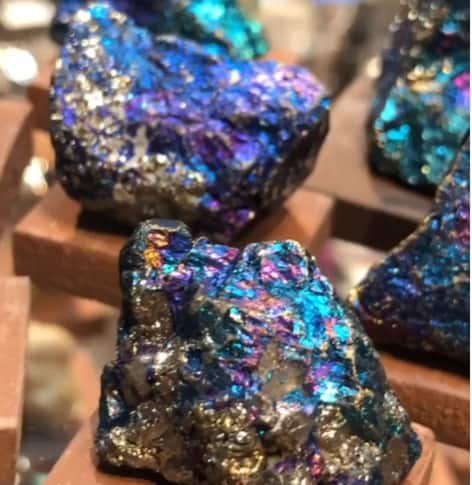Peacock Ore is reminiscent of a peacock’s tail feathers in color and brilliance but instead of having to take care of a peacock you can buy the ore and take it with you wherever you go. The rough material displays an iridescent color when viewed under light but don’t be fooled it’s an actual tarnish that resides on the surface of the stone.
The name peacock ore is for marketing purposes only and it is quite common for the gem and mineral industry to construct flashy or cool names to describe basic rocks and minerals.

What Is Peacock Ore?
Peacock Ore is a bit of a misnomer in that two different minerals result in the same effects. They would be chalcopyrite and bornite.
Both minerals often occur within the same deposits. Bornite is a copper ore, which is why the surface of the stone’s color looks so similar. However, not all bornite is peacock ore coming out of the ground, but excellent specimens can be found.
Here’s a fun fact, peacock ore is sold as bornite, but it’s actually chalcopyrite.

Peacock Ore Chalcopyrite
Chalcopyrite is a copper iron sulfide mineral and is commonly seen in shades of green, grey, and yellow. When chalcopyrite gets exposed to acid, the color palette changes to shades of blue, violet, yellow, and deep purple. “Treated” chalcopyrite is what we find at most gem and minerals shows and rock shops. Still, it’s referred to as “Peacock Ore.”
Genuine, natural peacock ore is actually bornite, which naturally tarnishes and is on the rare side. That is why they treat chalcopyrite so that the dealers can meet the public’s demand for this type of mineral.

Is Peacock Ore Natural?
Yes, peacock ore is a naturally-occurring stone if you’re talking about the bornite version. More than likely you have a piece of chalcopyrite that has been chemically treated to produce iridescence on the surface. The surface of freshly broken bornite is brownish-gold, but after a few days, it begins to turn purple, and in a few more weeks, it’ll turn blue. Chalcopyrite or “fake” peacock ore is bright yellowish-gold when broken. Chalcopyrite doesn’t naturally tarnish and remains yellow-gold unless it’s chemically treated.
Is Peacock Ore Man Made?
Chalcopyrite can be considered artificial. The most common enhancement for chalcopyrite is an acid treatment.
Rock and mineral dealers will purposefully tarnish specimens by exposing them to acid solutions, including concentrated sulfuric acid and diluted citric acid. Once treated, the chalcopyrite will display the entire rainbow spectrum, with blue and purple being predominant and reds and greens being common. That said, chalcopyrite would not tarnish naturally.
Is Peacock Ore Toxic?
Currently, the toxicity of peacock ore isn’t enough to make it on the list of highly toxic minerals. However, some sources do list bornite as having high toxicity.
Being an ore of copper, these stones will naturally have a high content of copper, that’s about 63 percent. With that much copper available, combined with sulfur, many will categorize peacock ore as being toxic. When handled with care and without being ingested, toxic exposure will be insignificant.
Again, bornite isn’t a hundred percent toxic, but it contains many minerals and elements in trace amounts that can be toxic to us. It’s not advised to put your tongue to the stones or inhale dust particles from them.
Where Is Peacock Ore Found?
It’s been said that the largest, most distinct bornite crystals hail from Dzhezkazgan, Kazakhstan but there are quite a few mines producing this material. Good quality specimens can also be sourced from Shaba, Congo, and a mine in Mhangura, Zimbabwe.
Peacock Ore is also commonly found in Arizona, Connecticut, Montana, Morocco, and Peru.
If you’re interested in major Chalcopyrite deposits, those are located in Australia, China, Canada, Great Britain, Germany, Japan, Spain, Peru, and the United States (Arizona, Colorado, and Utah).
What Is Peacock Ore Good For?
Because the tarnish on peacock ore is only on the surface level, it’s so thin that the colors are easily buffed away. This is why we can’t find polished peacock ore.
While peacock ore isn’t best for jewelry, apart from being favored by rock collectors, these stones are used in aesthetic and decorative items for homes and offices. Still, some specimens are cut en cabochon for necklaces, bracelets, pendants, cufflinks, and earrings.
- Identify Enstatite - March 12, 2024
- Identify Cerussite - March 3, 2024
- Identify Bytownite - February 18, 2024
